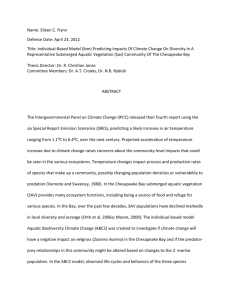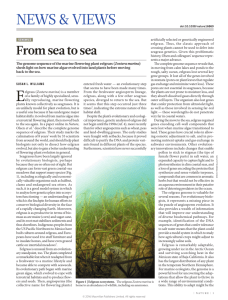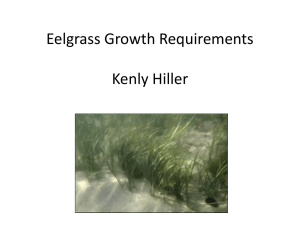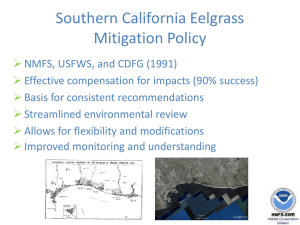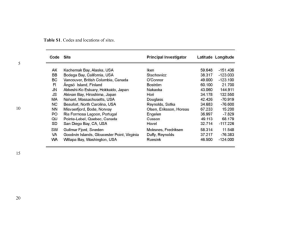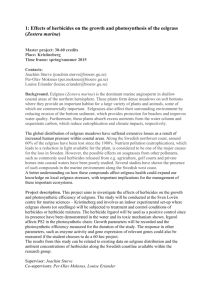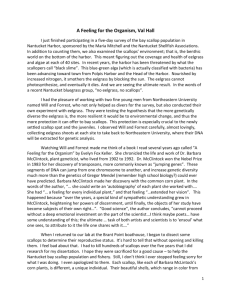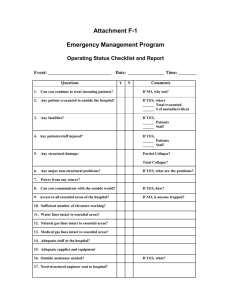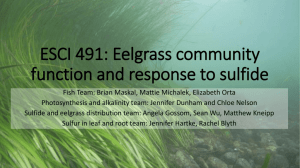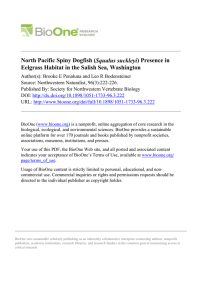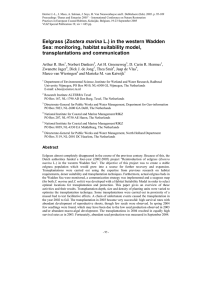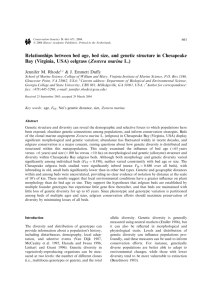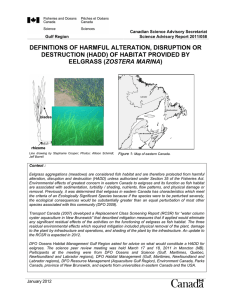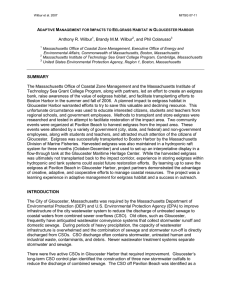seagrass - Solent Forum
advertisement
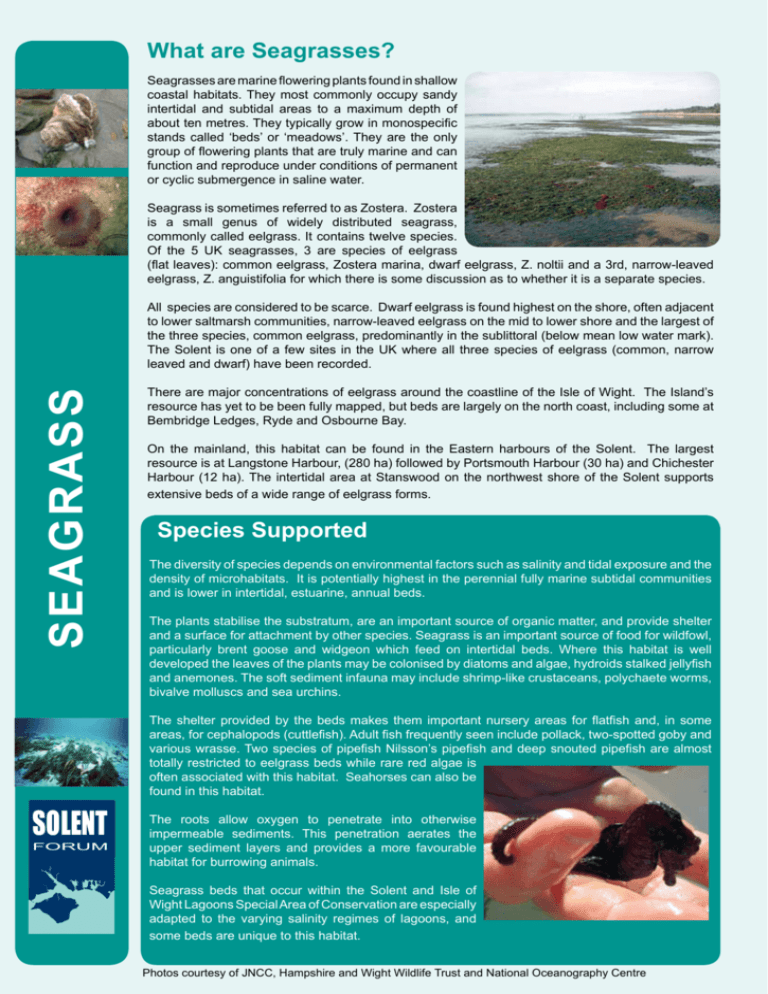
What are Seagrasses? Seagrasses are marine flowering plants found in shallow coastal habitats. They most commonly occupy sandy intertidal and subtidal areas to a maximum depth of about ten metres. They typically grow in monospecific stands called ‘beds’ or ‘meadows’. They are the only group of flowering plants that are truly marine and can function and reproduce under conditions of permanent or cyclic submergence in saline water. Seagrass is sometimes referred to as Zostera. Zostera is a small genus of widely distributed seagrass, commonly called eelgrass. It contains twelve species. Of the 5 UK seagrasses, 3 are species of eelgrass (flat leaves): common eelgrass, Zostera marina, dwarf eelgrass, Z. noltii and a 3rd, narrow-leaved eelgrass, Z. anguistifolia for which there is some discussion as to whether it is a separate species. SEAGRASS All species are considered to be scarce. Dwarf eelgrass is found highest on the shore, often adjacent to lower saltmarsh communities, narrow-leaved eelgrass on the mid to lower shore and the largest of the three species, common eelgrass, predominantly in the sublittoral (below mean low water mark). The Solent is one of a few sites in the UK where all three species of eelgrass (common, narrow leaved and dwarf) have been recorded. There are major concentrations of eelgrass around the coastline of the Isle of Wight. The Island’s resource has yet to be been fully mapped, but beds are largely on the north coast, including some at Bembridge Ledges, Ryde and Osbourne Bay. On the mainland, this habitat can be found in the Eastern harbours of the Solent. The largest resource is at Langstone Harbour, (280 ha) followed by Portsmouth Harbour (30 ha) and Chichester Harbour (12 ha). The intertidal area at Stanswood on the northwest shore of the Solent supports extensive beds of a wide range of eelgrass forms. Species Supported The diversity of species depends on environmental factors such as salinity and tidal exposure and the density of microhabitats. It is potentially highest in the perennial fully marine subtidal communities and is lower in intertidal, estuarine, annual beds. The plants stabilise the substratum, are an important source of organic matter, and provide shelter and a surface for attachment by other species. Seagrass is an important source of food for wildfowl, particularly brent goose and widgeon which feed on intertidal beds. Where this habitat is well developed the leaves of the plants may be colonised by diatoms and algae, hydroids stalked jellyfish and anemones. The soft sediment infauna may include shrimp-like crustaceans, polychaete worms, bivalve molluscs and sea urchins. The shelter provided by the beds makes them important nursery areas for flatfish and, in some areas, for cephalopods (cuttlefish). Adult fish frequently seen include pollack, two-spotted goby and various wrasse. Two species of pipefish Nilsson’s pipefish and deep snouted pipefish are almost totally restricted to eelgrass beds while rare red algae is often associated with this habitat. Seahorses can also be found in this habitat. SOLENT FORUM The roots allow oxygen to penetrate into otherwise impermeable sediments. This penetration aerates the upper sediment layers and provides a more favourable habitat for burrowing animals. Seagrass beds that occur within the Solent and Isle of Wight Lagoons Special Area of Conservation are especially adapted to the varying salinity regimes of lagoons, and some beds are unique to this habitat. Photos courtesy of JNCC, Hampshire and Wight Wildlife Trust and National Oceanography Centre Economic and Social Value Seagrass beds are an important source of food and shelter for the young stages of many fish and crustacean species, some of which are themselves food for commercially valuable fishery species. They are also important feeding grounds for ducks and geese and are sought after by wildfowlers. Eelgrass plants play an important role in maintaining the stability of the shoreline. Their dense network of rhizomes binds the sediment and reduces erosion in shallow waters. If beds are locally destroyed, their protective capacity can only be replaced by financially costly artificial shoreline reinforcements. Designations Estuaries are one of the primary Annex 1 habitats for which the ‘Solent Maritime’ has been designated a Special Area of Conservation (SAC) under the EC Habitats Directive. Sediment habitats within its estuaries include extensive estuarine flats, often with intertidal areas supporting eelgrass beds. All intertidal eelgrass beds within the SAC are designated as Sites of Special Scientific Interest (SSSI). Eelgrass beds that occur in the Solent’s lagoons are designated under the Solent and Isle of Wight Lagoons SAC. The EU Water Framework Directive requires all inland and coastal waters to reach “good status” by 2015 and will establish demanding environmental objectives, including ecological targets for surface waters. This should help to protect this habitat from pollution and ensure that its water quality remains ecologically sound. Eelgrass beds appear as a priority habitat in the UK Biodiversity Action Plan. This seeks to maintain the extent and distribution of eelgrass beds in UK waters. Issues, Threats and Opportunities • Disease - a wasting disease was responsible for the die-back of large areas of eelgrass in the UK in the 1930s and is thought still to be having an adverse effect. • Natural cycles - the extent of eelgrass beds may change as a result of natural factors such as severe storms, exposure to air, and freshwater inundation. Grazing by wildfowl can have a dramatic seasonal effect. Warm sea temperatures, coupled with low level of sunlight, may cause significant stress and die back. • Coastal development - waterside development or the construction of sea defences all have the potential to change the hydrological and sediment regime of this habitat, which may lead to a loss of or changes in habitat distribution. • Human disturbance - for example through trampling, anchoring, dredging, and use of mobile bottom fishing gear can all damage the fragile plants. • Alien species - the introduction of, and competition from, alien species such as Spartina anglica and Sargassum muticum. • Increased turbidity - the mixing of sediment in the water column, due to dredging or spoil disposal, reduces the plants ability for photosynthesis. • Nutrient enrichment - at low levels, this may increase production of eelgrass while high nitrate concentrations have been implicated in the decline of mature common eelgrass. Phytoplankton blooms, resulting from nutrient enrichment, have been shown to reduce biomass and depth penetration of eelgrass. • Marine pollution - eelgrass is known to accumulate tributyl-tin and possibly other metals and organic pollutants. Several heavy metals and organic substances have been shown to reduce nitrogen fixation which may affect the viability of the plant, particularly in nutrient poor conditions. Accumulated pollutants may become concentrated through food chains.
